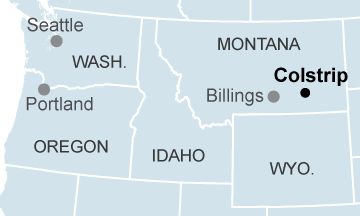Long-Dreary Outlook for Two Montana Coal-Fired Plants Has Gotten Worse

 In the weeks that have passed since we published “A Bleak Future for Colstrip Units 1 and 2,” the outlook for the these two coal-fired electric generators in eastern Montana has only gotten worse.
In the weeks that have passed since we published “A Bleak Future for Colstrip Units 1 and 2,” the outlook for the these two coal-fired electric generators in eastern Montana has only gotten worse.
Our report assumed, based on market expectations, that natural gas prices and energy prices would remain low for the next 10 years. That’s still the case, but forward-looking market indicators today are for natural gas and energy market prices to drop even further than we assumed in June.
That means that keeping Colstrip 1 and 2 running is an even worse proposition for its owners, Talen Montana and the ratepayers of Puget Sound Energy, than our June report showed.
Ownership of Colstrip 1 and 2 is shared equally by Talen, a company that sells power into wholesale markets, and Puget Sound Energy, a utility that provides electricity to residential and commercial customers in 10 counties in Washington State.
We said in June—and we say now—that the only sensible solution for Colstrip 1 and 2 is plan now for the phase-out of these units in favor of more affordable alternatives.
REVENUES FROM COLSTRIP 1 AND 2 HAVE PLUMMETED IN RECENT YEARS, and the energy market landscape makes a reversal of this trend unlikely. Indeed, the probability of higher generating costs and lower natural gas and power market prices over the next few years only highlights the financial vulnerability of Colstrip 1 and 2. Talen Montana will earn relatively small profits on the units, at best; what’s more likely is that it will lose money. Similarly, Colstrip 1 and 2 stand to make electricity bills for Puget Sound Energy customers higher than they should be.
We aren’t alone in our assessment. Julien Dumoulin-Smith, a leading energy analyst at UBS Financial has put it just as bluntly, arguing for outright retirement rather than rejiggering the units to modernize them:
“Putting more money into these plants is not palatable. If push comes to shove, it would make more sense to retire than to invest money in scrubbers.”
Puget Sound Energy knows all this—and has had an inkling for a long time. As far back as 2013, the company published a formal integrated resource plan showing how continued ownership of Colstrip 1 2 would not be cost-effective for its customers, especially when allowances were made for the substantial reductions in expected future natural gas prices and Mid-Columbia Hub power prices.
It’s 2015 now, and it’s time to move toward retiring these two costly and outdated plants.
David Schlissel is IEEFA’s director of resources planning analysis.
















